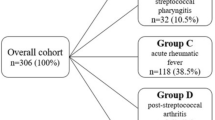Abstract
Clinicians frequently request serologic tests to provide evidence of prior infection by Streptococcus pyogenes, especially when suspecting a diagnosis of acute rheumatic fever or post-streptococcal glomerulonephritis. However, the interpretation of these tests is difficult and should take account of the clinical features, epidemiological setting, and pre-test probability, as well as the specific aspects of the assay. This review details the characteristics of streptococcal serologic assays and provides recommendations for their use and interpretation.
Similar content being viewed by others
References
Carapetis JR, Steer AC, Mulholland EK, Weber M (2005) The global burden of group A streptococcal diseases. Lancet Infect Dis 5:685–694. doi:10.1016/S1473-3099(05)70267-X
Tandon R, Sharma M, Chandrashekhar Y, Kotb M, Yacoub MH, Narula J (2013) Revisiting the pathogenesis of rheumatic fever and carditis. Nat Rev Cardiol 10:171–177. doi:10.1038/nrcardio.2012.197
Rodríguez-Iturbe B, Batsford S (2007) Pathogenesis of poststreptococcal glomerulonephritis a century after Clemens von Pirquet. Kidney Int 71:1094–1104. doi:10.1038/sj.ki.5002169
Johnson DR, Kurlan R, Leckman J, Kaplan EL (2010) The human immune response to streptococcal extracellular antigens: clinical, diagnostic, and potential pathogenetic implications. Clin Infect Dis 15(50):481–490. doi:10.1086/650167
Kurlan R, Johnson D, Kaplan EL; Tourette Syndrome Study Group (2008) Streptococcal infection and exacerbations of childhood tics and obsessive–compulsive symptoms: a prospective blinded cohort study. Pediatrics 121:1188–1197. doi:10.1542/peds.2007-2657
Shulman ST, Bisno AL, Clegg HW, Gerber MA, Kaplan EL, Lee G et al (2012) Clinical practice guideline for the diagnosis and management of group A streptococcal pharyngitis: 2012 update by the Infectious Diseases Society of America. Clin Infect Dis 15(55):1279–1282. doi:10.1093/cid/cis847
Wannamaker LW, Ayoub EM (1960) Antibody titers in acute rheumatic fever. Circulation 21:598–614
Walker MJ, Barnett TC, McArthur JD, Cole JN, Gillen CM, Henningham A et al (2014) Disease manifestations and pathogenic mechanisms of group A Streptococcus. Clin Microbiol Rev 27:264–301. doi:10.1128/CMR.00101-13
Shet A, Kaplan EL (2002) Clinical use and interpretation of group A streptococcal antibody tests: a practical approach for the pediatrician or primary care physician. Pediatr Infect Dis J 21:420–426, quiz 427–30
Kaplan EL, Huew BB (1980) The sensitivity and specificity of an agglutination test for antibodies to streptococcal extracellular antigens: a quantitative analysis and comparison of the streptozyme test with the anti-streptolysin O and anti-deoxyribonuclease B tests. J Pediatr 96:367–373
Gerber MA, Wright LL, Randolph MF (1987) Streptozyme® test for antibodies to group A streptococcal antigens. Pediatr Infect Dis J 6:36–40
Todd EW (1938) The differentiation of two distinct serological varieties of streptolysin, streptolysin O and streptolysin S. J Path Bact 47:423
Alouf JE (1980) Streptococcal toxins (streptolysin O, streptolysin S, erythrogenic toxin). Pharmacol Ther 11:661–717
Johnson DR, Kaplan EL, Sramek J, Bicova R, Havlicek J, Havlickova H et al (1996) Laboratory diagnosis of group A streptococcal infections. World Health Organization, Geneva
Spaun J, Bentzon MW, Larsen SO, Hewitt LF (1961) International standard for antistreptolysin-O. Bull World Health Organ 24:271–279
Walker MJ, Hollands A, Sanderson-Smith ML, Cole JN, Kirk JK, Henningham A et al (2007) DNase Sda1 provides selection pressure for a switch to invasive group A streptococcal infection. Nat Med 13:981–985. doi:10.1038/nm1612
Ayoub EM, Wannamaker LW (1962) Evaluation of the streptococcal deoxyribonuclease B and diphosphopyridine nucleotide antibody tests in acute rheumatic fever and acute glomerulonephritis. Pediatrics 29:527–538
Kaplan EL, Anthony BF, Chapman SS, Ayoub EM, Wannamaker LW (1970) The influence of the site of infection on the immune response to group A streptococci. J Clin Invest 49(7):1405–1414. doi:10.1172/JCI106358
Kaplan EL, Rothermel CD, Johnson DR (1998) Antistreptolysin O and anti-deoxyribonuclease B titers: normal values for children ages 2 to 12 in the United States. Pediatrics 101:86–88
Danchin MH, Carlin JB, Devenish W, Nolan TM, Carapetis JR (2005) New normal ranges of antistreptolysin O and antideoxyribonuclease B titres for Australian children. J Paediatr Child Health 41:583–586. doi:10.1111/j.1440-1754.2005.00726.x
Steer AC, Vidmar S, Ritika R, Kado J, Batzloff M, Jenney AWJ et al (2009) Normal ranges of streptococcal antibody titers are similar whether streptococci are endemic to the setting or not. Clin Vaccine Immunol 16:172–5. doi:10.1128/CVI.00291-08
Karmarkar MG, Venugopal V, Joshi L, Kamboj R (2004) Evaluation & revaluation of upper limits of normal values of anti-streptolysin O & anti-deoxyribonuclease B in Mumbai. Indian J Med Res 119(Suppl):26–28
[No authors listed] (1992) Guidelines for the diagnosis of rheumatic fever. Jones Criteria, 1992 update. Special Writing Group of the Committee on Rheumatic Fever, Endocarditis, and Kawasaki Disease of the Council on Cardiovascular Disease in the Young of the American Heart Association. JAMA 268:2069–2073
Pelloux H, Fricker-Hidalgo H, Brochier G, Goullier-Fleuret A, Ambroise-Thomas P (1999) Intravenous immunoglobulin therapy: confounding effects on serological screening for toxoplasmosis during pregnancy. J Clin Microbiol 37:3423–3424
Lichtiger B, Rogge K (1991) Spurious serologic test results in patients receiving infusions of intravenous immune gammaglobulin. Arch Pathol Lab Med 115:467–469
Hill HR (2010) Group A streptococcal carrier versus acute infection: the continuing dilemma. Clin Infect Dis 15(50):491–492. doi:10.1086/650168
RHDAustralia (ARF/RHD writing group), National Heart Foundation of Australia and the Cardiac Society of Australia and New Zealand, Carapetis JR, Brown A, Maguire G, Walsh W, Noonan S, Thompson D (2012) Australian guideline for prevention, diagnosis and management of acute rheumatic fever and rheumatic heart disease (2nd edition). Available online at: http://www.rhdaustralia.org.au/resources/arf-rhd-guideline
Klein GC, Baker CN, Jones WL (1971) “Upper limits of normal” antistreptolysin O and antideoxyribonuclease B titers. Appl Microbiol 21:999–1001
Conflict of interest
The authors declare that they have no conflict of interest.
Author information
Authors and Affiliations
Corresponding author
Rights and permissions
About this article
Cite this article
Parks, T., Smeesters, P.R., Curtis, N. et al. ASO titer or not? When to use streptococcal serology: a guide for clinicians. Eur J Clin Microbiol Infect Dis 34, 845–849 (2015). https://doi.org/10.1007/s10096-014-2303-8
Received:
Accepted:
Published:
Issue Date:
DOI: https://doi.org/10.1007/s10096-014-2303-8




